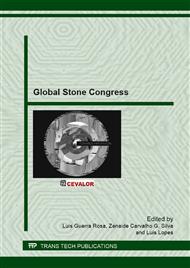p.39
p.48
p.57
p.65
p.72
p.82
p.90
p.98
p.106
A New Laboratory Methodology for Assessing the Cutting Behaviour of Gangsawing Blades
Abstract:
The objective of this work is to present a new laboratory testing methodology suitable for estimate the forces generated during multiple blade gangsawing employed on marble and limestone. This methodology allows analysing the tool behaviour aiming to contribute for developing new products and/or optimize the working conditions for processing different classes of stones. In the present research, 3 different diamond linear blades were tested against 2 types of stones (limestone and marble), studying the effect of two working parameters. The linear blades differ in the characteristics of the segments: size of diamond grit and type of metallic binders used to embed the diamond. The classification equipment used in this work consists in a special bridge cutting machine incorporating a tailored instrumentation / sensing system to control the working conditions while all the necessary cutting outputs are monitored and stored by special software. Taking into account the output parameters measured to evaluate the tool behaviour (vertical and horizontal forces, electric energy consumption, vibrations measured by accelerometers and tool wear); it is possible to classify and select tools with relation to the efficacy of the cut.
Info:
Periodical:
Pages:
72-81
Citation:
Online since:
April 2013
Keywords:
Price:
Сopyright:
© 2013 Trans Tech Publications Ltd. All Rights Reserved
Share:
Citation:


